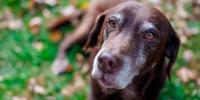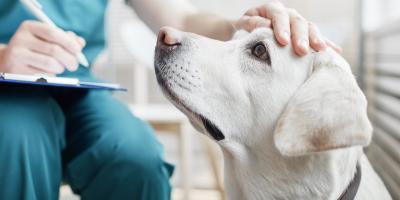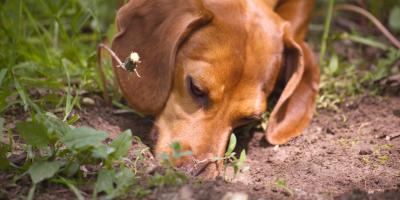
Dog Skin Cancer: Symptoms & Treatment


You may be surprised to learn that dogs can get skin cancer. It’s true, our canine companions are mostly covered in fur, which protects them from overexposure to the sun – one of the leading causes of this illness.
Many dogs do have areas with little to no hair, however, while others have thin coats, leaving them vulnerable. Additionally, dog skin cancer isn’t only caused by ultraviolet (UV) rays. There are other reasons your pet may get the disease.
If you’re wondering, What does skin cancer look like on a dog? because you’re curious about a growth on your pet, it’s important to know that not all skin cancer is malignant.
Read on to learn more about the causes of dog skin cancer, how to identify the symptoms, and what treatment options are available.
Can Dogs Get Skin Cancer?
Yes, dogs can get skin cancer. In fact, for canines, skin tumors are the most commonly diagnosed type of tumor.
Just like with humans, excessive exposure to the sun can lead to UV radiation for dogs. This can affect their ears, nose and belly – areas where fur may be sparse or nonexistent.
Unfortunately, these aren’t the only places where skin cancer may occur. Dogs with thin coats are potentially susceptible all over their bodies.
Among skin conditions in dogs, the disease may be less common than, say, allergies, but it’s still important to take precautions and understand the signs of skin cancer to protect your pet.
What Are the Signs of Skin Cancer in Dogs?
- Skin lesions
- Unusual scabs or bumps
- Discoloration or redness
- Excessive scratching or chewing at the skin
- Growths resembling warts
Fortunately, not all growths on your dog’s skin are cancerous. Skin tags, for example, are often benign.
Only your veterinarian will know for certain, though. If you find a lump on your dog’s skin, contact your veterinarian so they can examine it.
Types of Dog Skin Cancer
There are a few different types of dog skin cancer. They vary depending on whether they’re malignant or benign, the location on your pet’s body, and the cancer’s cause.

Mast Cell Tumors
Often characterized by the presence of a red, raised lump and swelling, mast cell tumors are the most common type of skin tumor for dogs. Additional signs may include itchiness, skin irritation and severe allergic reactions.
Mast cell tumors are malignant, usually occur in older dogs, and are more commonly seen in breeds such as Boxers, Bulldogs, Staffordshire Terriers and others.
Squamous Cell Carcinomas
This tumor often appears on older dogs, especially those with shorter hair and who spend a lot of time outdoors. Typically, they appear as red, ulcerated masses on the skin.
Melanomas
Often found inside the mouth, lips or nail beds, malignant melanomas are dangerous as they can spread quickly throughout the body. Symptoms include swelling and redness, as well as black or pink masses on the lips, mouth and toes.
Benign Skin Cancers in Dogs
While some skin cancers in dogs are malignant, others are non-life-threatening. These include conditions such as lipomas, histiocytomas and papillomas, and are often marked by growths on your pet’s body.
Some benign skin cancer growths go away on their own, but notify your veterinarian about any unusual developments on your dog’s skin.
Dog Skin Cancer or Wart?
You may be understandably concerned if you find an abnormal growth on your dog’s skin.
Is it skin cancer or a wart? Generally, warts, which are benign, are round and firm. Skin cancer symptoms more commonly include lesions and discoloration, but they may also include wart-like growths.
Bottom line? If you find a strange growth on your dog, contact your veterinarian.
What Causes Skin Cancer in Dogs?
- Sun exposure. Dogs with light skin color and thin coats are particularly vulnerable to UV rays.
- Genetics. Inherited genes that suppress tumor growth may be a factor.
- Trauma. Tissue damage that results from an injury may be susceptible to skin tumor growth.
- Environmental factors. It’s possible that conditions such as chemicals in the air may contribute to skin tumors.
While some breeds can be more prone to skin cancer than others, remember every dog is different. Even if your pet meets certain risk factors, they have their own unique level of predisposition to cancer.
That said, it’s best to be cautious and protect them from the causes of skin cancer whenever possible.
How is Dog Skin Cancer Treated?
Treatment for skin cancer in dogs varies. Factors such as cancer type, stage and location all play a role in determining the best course of action.
If your pet has a malignant cancerous lump, it’s likely your veterinarian will recommend surgery, especially if it’s located in an accessible area.
Chemotherapy can also be a potent treatment if the cancer has spread throughout the body. Additionally, radiation is sometimes used to target specific tumors in areas where surgery is challenging.
Treatment can become more complicated for malignant melanoma. It’s not uncommon for this to spread to your pet’s lymph nodes. In this case, chemotherapy and surgery may be used together.
For benign lumps, your veterinarian might recommend you monitor them. If they irritate your pet or become infected, then treatment may be prescribed.
How to Prevent Dog Skin Cancer
There is no guaranteed form of protection from skin cancer for your dog. That doesn’t mean you can’t help keep them safe, though.
Here are some steps you can take to limit their chances of developing a skin tumor:
- Limit UV exposure. If possible, try to walk and play with your dog in the morning or late day when the sun is less intense.
- Apply sunscreen. As with humans, sunscreen protects your pet’s skin from harmful UV rays. Make sure to apply it on areas where their skin is most exposed, such as the nose, ears and belly.
- Check your dog’s skin often. Closely inspect your pet on a consistent basis for any unusual growths or skin conditions.
- Maintain regular veterinarian checkups. In addition to your examinations at home, make sure your dog is seen by a veterinarian at least annually for close inspection.
Skin cancer in dogs can seem scary, but with knowledge and prevention, you can improve your canine companion’s chances of living a long, healthy life.
Want more tips? Check out our collection of dog health articles for insight from our Pet Experts.

Reward Yourself with myPurina
Earn and redeem rewards for Purina products with the myPurina app.



